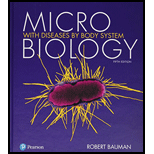
Microbiology with Diseases by Body System (5th Edition)
5th Edition
ISBN: 9780134477206
Author: Robert W. Bauman Ph.D.
Publisher: PEARSON
expand_more
expand_more
format_list_bulleted
Concept explainers
Question
Chapter 17, Problem 7MC
Summary Introduction
Introduction:
Serology is a method which is used to analyze the blood for the presence of a specific antibody and antigens. There is wide-range of serological tests available to recognize the antigens or antibodies in the blood. Using tagged or labelled antibody to identify an antigen is an altered form of serological testing method, for example, fluorescent antibody tests.
Expert Solution & Answer
Want to see the full answer?
Check out a sample textbook solution
Students have asked these similar questions
Standard Concentration (caffeine) mg/L
Absorbance Reading
10
0.322
20
0.697
40
1.535
60
2.520
80
3.100
Please draw in the missing answer, thank you
Please fill in all blank questions, Thank you
Chapter 17 Solutions
Microbiology with Diseases by Body System (5th Edition)
Ch. 17 - Prob. 1TMWCh. 17 - A diagnostician used an ELISA to show that a...Ch. 17 - To obtain immediate immunity against tetanus, a...Ch. 17 - Which of the following vaccine types is commonly...Ch. 17 - Prob. 3MCCh. 17 - When antigen and antibodies combine, maximal...Ch. 17 - An anti-antibody is used when _________. a. an...Ch. 17 - Prob. 6MCCh. 17 - Prob. 7MCCh. 17 - Prob. 8MC
Ch. 17 - Prob. 9MCCh. 17 - Prob. 10MCCh. 17 - Prob. 11MCCh. 17 - An antiserum is ________. a. an anti-antibody b....Ch. 17 - Prob. 13MCCh. 17 - Prob. 14MCCh. 17 - Prob. 15MCCh. 17 - Prob. 1MTFCh. 17 - Prob. 2MTFCh. 17 - Prob. 3MTFCh. 17 - Modified True/False 4. _________________ ELISA is...Ch. 17 - Prob. 5MTFCh. 17 - Match the characteristic in the first column with...Ch. 17 - Identify the chemicals represented by this artists...Ch. 17 - Prob. 2VICh. 17 - Compare and contrast the Chinese practice of...Ch. 17 - What are the advantages and disadvantages of...Ch. 17 - Compare the advantages and disadvantages of...Ch. 17 - How does precipitation differ from agglutination?Ch. 17 - Explain how a pregnancy test works at the...Ch. 17 - Compare and contrast herd immunity and contact...Ch. 17 - How does nephelometry differ from turbidimetry?Ch. 17 - Is it ethical to approve the use of a vaccine that...Ch. 17 - Which is worse: to use a diagnostic test for HIV...Ch. 17 - Discuss the importance of costs and technical...Ch. 17 - What bodily fluids, in addition to blood serum,...Ch. 17 - Why might a serological test give a false positive...Ch. 17 - Some researchers want to distinguish B cells from...Ch. 17 - Describe three ways by which genetic recombinant...Ch. 17 - How does a toxoid vaccine differ from an...Ch. 17 - Explain why many health organizations promote...Ch. 17 - Contrast a hemagglutination test with a viral...Ch. 17 - Prob. 11CTCh. 17 - Draw a picture showing, at both the molecular and...Ch. 17 - Using the following terms, fill in the following...
Knowledge Booster
Learn more about
Need a deep-dive on the concept behind this application? Look no further. Learn more about this topic, biology and related others by exploring similar questions and additional content below.Similar questions
- please fill in missing parts , thank youarrow_forwardplease draw in the answers, thank youarrow_forwarda. On this first grid, assume that the DNA and RNA templates are read left to right. DNA DNA mRNA codon tRNA anticodon polypeptide _strand strand C с A T G A U G C A TRP b. Now do this AGAIN assuming that the DNA and RNA templates are read right to left. DNA DNA strand strand C mRNA codon tRNA anticodon polypeptide 0 A T G A U G с A TRParrow_forward
- Please identify the curve shown below. What does this curve represent? Please identify A, B, C, D, and E (the orange oval). What is occurring in these regions?arrow_forwardPlease identify the test shown here. 1) What is the test? 2) What does the test indicate? How is it performed? What is CX? 3) Why might the test be performed in a clinical setting? GEN CZ CX CPZ PTZ CACarrow_forwardDetermine how much ATP would a cell produce when using fermentation of a 50 mM glucose solution?arrow_forward
- Determine how much ATP would a cell produce when using aerobic respiration of a 7 mM glucose solution?arrow_forwardDetermine how much ATP would a cell produce when using aerobic respiration to degrade one small protein molecule into 12 molecules of malic acid, how many ATP would that cell make? Malic acid is an intermediate in the Krebs cycle. Assume there is no other carbon source and no acetyl-CoA.arrow_forwardIdentify each of the major endocrine glandsarrow_forward
arrow_back_ios
SEE MORE QUESTIONS
arrow_forward_ios
Recommended textbooks for you
 Comprehensive Medical Assisting: Administrative a...NursingISBN:9781305964792Author:Wilburta Q. Lindh, Carol D. Tamparo, Barbara M. Dahl, Julie Morris, Cindy CorreaPublisher:Cengage Learning
Comprehensive Medical Assisting: Administrative a...NursingISBN:9781305964792Author:Wilburta Q. Lindh, Carol D. Tamparo, Barbara M. Dahl, Julie Morris, Cindy CorreaPublisher:Cengage Learning


Comprehensive Medical Assisting: Administrative a...
Nursing
ISBN:9781305964792
Author:Wilburta Q. Lindh, Carol D. Tamparo, Barbara M. Dahl, Julie Morris, Cindy Correa
Publisher:Cengage Learning



